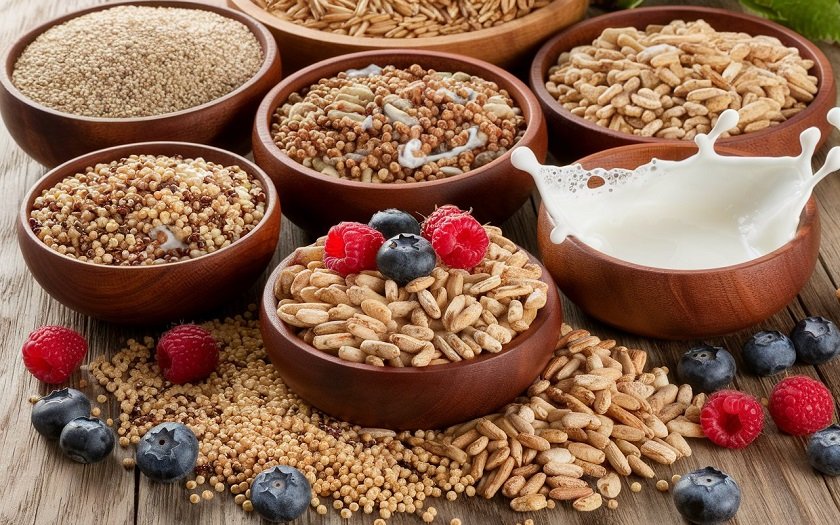Ancient grains have recently gained significant attention for their nutritional value, unique flavors, and historical significance. As the world embraces more sustainable and health-conscious eating habits, these grains are emerging as star ingredients in modern food products, particularly breakfast cereals. This article delves into the world of ancient grains, exploring their benefits, how they are used in cereals, and why they should be an essential part of your diet.
Introduction: Rediscovering Ancient Grains
Ancient grains are a group of grains that have been largely unchanged over the centuries, cultivated and consumed by various ancient civilizations for thousands of years. Unlike the more commonly used grains like wheat, rice, and corn, these grains have remained relatively untouched by modern agricultural practices. Their unaltered nature makes them a valuable source of nutrition, and many are now being incorporated into breakfast cereals as a way to boost health benefits.
With the growing emphasis on whole, nutrient-dense foods, cereals made from ancient grains have become a popular choice for health-conscious individuals. From quinoa and farro to amaranth and spelt, these grains are not only rich in vitamins, minerals, and fiber but also offer a host of other health advantages. In this guide, we’ll explore what ancient grains are, their benefits, and how they’re used in cereals.
What Are Ancient Grains?
Ancient grains refer to cereal grains that have been grown for thousands of years with little modification. These grains are known for their ability to thrive in various climates and have a strong historical and cultural significance. Some of the most well-known ancient grains include:
- Quinoa: Known for being a complete protein, quinoa is a staple of ancient Incan diets and is packed with amino acids, fiber, and antioxidants.
- Amaranth: A tiny but mighty grain that was a staple of the Aztec and Inca civilizations, amaranth is high in protein, fiber, and essential minerals like iron and magnesium.
- Spelt: A close relative to wheat, spelt has a slightly nuttier flavor and is higher in fiber and protein than modern wheat.
- Farro: Often associated with ancient Rome, farro is a chewy, nutty grain that is rich in fiber, protein, and B vitamins.
- Millet: One of the oldest cultivated grains, millet was commonly eaten by early civilizations like the Egyptians and Chinese. It’s rich in magnesium, phosphorus, and fiber.
- Teff: A staple of Ethiopian cuisine, teff is a tiny grain that is high in iron, calcium, and protein. It’s often used to make traditional injera bread.
These grains are typically whole grains, meaning they retain their bran, germ, and endosperm, making them more nutritious than refined grains. Because they are less processed, they provide a richer source of fiber, vitamins, and minerals, making them ideal additions to breakfast cereals.
Benefits of Ancient Grains in Cereal
Incorporating ancient grains into your diet through cereal offers a wealth of health benefits. Here are some of the key reasons why ancient grains should be a regular part of your morning routine:
-
Nutrient Density
Ancient grains are packed with essential nutrients that are often lacking in more refined grains. They provide significant amounts of protein, fiber, healthy fats, vitamins, and minerals. For instance, quinoa is one of the few plant-based foods that contain all nine essential amino acids, making it a complete protein source. Amaranth is rich in iron and magnesium, which are important for energy production and bone health.
-
High Fiber Content
Fiber is a crucial nutrient that helps maintain digestive health, regulates blood sugar levels, and promotes satiety. Ancient grains are often much higher in fiber than modern grains like white rice or refined wheat. Farro, for example, is known for its high fiber content, which helps keep you feeling fuller for longer and promotes a healthy digestive system.
-
Gluten-Free Options
For individuals with celiac disease or gluten sensitivity, some ancient grains, like quinoa, millet, and amaranth, are naturally gluten-free, making them an excellent alternative to wheat-based cereals. These gluten-free ancient grains can provide a similar texture and taste to traditional cereals while offering a wealth of nutritional benefits.
-
Rich in Antioxidants
Many ancient grains contain antioxidants that help protect the body from oxidative stress, which can lead to chronic diseases and aging. For example, teff is known to have high antioxidant levels, particularly in the form of flavonoids, which support immune function and protect against inflammation.
-
Sustainable Farming Practices
Ancient grains are often cultivated using sustainable and eco-friendly farming practices. These grains are resilient and adaptable to various climates, making them less dependent on chemical fertilizers and pesticides. By supporting the consumption of ancient grains, consumers are also supporting more environmentally friendly agricultural practices.
How Ancient Grains Are Used in Breakfast Cereal
Ancient grains are increasingly being used in a variety of breakfast cereals due to their versatility and health benefits. They can be used in both hot and cold cereals, offering a range of textures and flavors to suit different preferences. Here are some ways ancient grains are used in cereal products:
-
Flaked Grains
Flaked ancient grains like quinoa, farro, and spelt are often used in ready-to-eat breakfast cereals. These grains are steamed and then flattened into flakes, similar to traditional cornflakes. The result is a crunchy, nutritious cereal that can be enjoyed with milk or yogurt.
-
Puffed Grains
Puffed ancient grains are light, airy, and often used in granola mixes or as the base for puffed cereal products. Quinoa, amaranth, and millet are commonly puffed to create an easy-to-eat, crunchy texture that pairs well with dried fruits and nuts in a breakfast bowl.
-
Whole Grain Porridge
Ancient grains can also be cooked into a warm, hearty porridge, similar to oatmeal. Farro and quinoa are excellent choices for porridge because of their nutty, chewy textures. These grains can be cooked with water or milk and flavored with spices like cinnamon, nutmeg, or vanilla.
-
Granola Bars and Snacks
Ancient grains are often featured in granola bars and cereal snacks, where they add both nutritional value and crunch. Amaranth and quinoa are commonly used in granola bar recipes, providing a boost of protein and fiber to keep you energized throughout the day.
Conclusion: Why You Should Include Ancient Grains in Your Cereal
Ancient grains are more than just a trend—they are a nutritious and sustainable addition to your breakfast routine. Rich in fiber, protein, vitamins, and minerals, these grains offer a wide range of health benefits, from supporting digestive health to reducing the risk of chronic diseases. By incorporating ancient grains into your breakfast cereal, you can enjoy a delicious, nutrient-dense meal that fuels your body for the day ahead.
Whether you prefer crunchy flaked cereals, warm porridge, or granola bars, there’s an ancient grain option for everyone. So, next time you’re shopping for cereal, consider choosing a product made with ancient grains to experience both the health benefits and the rich, satisfying flavors they provide.
(FAQs)
- Are ancient grains gluten-free?
Some ancient grains, such as quinoa, amaranth, millet, and teff, are naturally gluten-free, making them a great option for individuals with gluten sensitivity or celiac disease. However, other grains like spelt and farro do contain gluten, so it’s important to check product labels.
- What is the difference between ancient grains and modern grains?
Ancient grains have been cultivated for thousands of years with minimal genetic modification, while modern grains like wheat and corn have been selectively bred for specific traits, such as higher yields or easier processing. Ancient grains tend to be more nutrient-dense and less processed than modern grains.
- Can I substitute ancient grains for regular grains in recipes?
Yes! Many ancient grains can be substituted for traditional grains in various recipes. For example, you can use quinoa instead of rice, or farro instead of pasta, to increase the nutritional value of your meals.
- How do I cook ancient grains?
Ancient grains are generally cooked by boiling them in water or broth, much like rice or quinoa. Each grain has its own cooking time, so be sure to follow package instructions for best results. You can also add spices, herbs, or vegetables to enhance flavor.
- Are ancient grains more expensive than modern grains?
Ancient grains can be more expensive than modern grains due to their limited production and higher processing costs. However, many consumers view the added nutritional benefits and sustainability of ancient grains as a worthwhile investment in their health.

